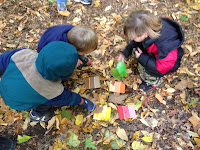Day 1--Paint Swatch Color Exploration!
Color is a fundamental element of art. Fall is a perfect time to explore color as the reds, oranges, yellows, and browns are vibrant. We explored color around Easter earlier this year at a nearby botanical garden, but it was a little too early to find all the colors we were searching. We also tried using natural dyes for our Easter Eggs as plants and other natural items have been used for color in artwork and more functional items for centuries.
1col·or
noun, often attributive \ˈkə-lər\
: a quality such as red, blue, green, yellow, etc., that you see when you look at something
: something used to give color to something : a pigment or dye
: the use or combination of colors
On our first Nature Art exploration for 30 Days of Nature Art, we'll look at a simple technique for exploring color--paint swatches! I have tried a few different things with paint swatches and nature.
1. Color Nature Walk--A very simple idea is to grab several colors that are typical of the season, punch a hole through them, and put them on a book ring for an instant nature walk companion. I like to find the ones with the windows cut out from Lowe's. Believe me, I've tried to hole punch them out, so I was happy when I found them precut! I also like the ones that have subtle hue differences along the card. I have used these from preschool age on up and the experience is different with each group. What I find, is that the colors help us slow down, focus, and notice the subtleties that are out there in nature.
This last fall, I used our fall color swatches for a family hike. It was so interesting to see the initial disinterest of the older boys turn into, "Mom, I found Autumn Spice!" I've also used the technique with a nature club--they really looked at the HUE rather than just calling it all pink. For younger children, using the basic color names seems to work well. This is an activity we return to each season. We have a different experience each time we bring it out. From this initial start, we can look at other extensions, such as talking about the names of the plants or natural materials, where it's found, seasonal differences, textures, etc.
2. Bringing Nature to the Swatch--Another option is to bring "nature" to the swatch. This allows more of a comparative look at actual differences of hue and varying materials. Rather than finding the color out in nature, bring nature together and sort it and categorize it to make sense of the subtle variations of color. For this activity, I took my cards off the ring and gave each child a different card. However, we ended up bringing them all back together to work as a group in finding variances of color. It was so sweet when a little girl found her bright red berry and matched it so well to her color. I wouldn't have noticed it myself! Various greens could also be used to match with leaves in spring or summer. As an extension, discuss the shapes, textures, and attributes of the leaves and trees.
3. Paint Chip Picture Walk--This website suggests documenting all the colors found through pictures. These can then be printed and made into a book. Of course, literacy connections can be made, collages of other colors can be shared, etc. I'd almost use the paint swatch as the actual pages of the book and put the pictures opposite--lots of options for creativity!
4. Clip Nature Colors--In a busy bag exchange last year, one of the mom's made a color match game, cutting part of the paint chip and gluing it to a clothespin. It was then matched and clipped onto the rest of the color swatch. Why not use these color chip clothespins to "clip" to nature as the color is found along the way? Leave a trail for someone else to find and then try it again!
5. Of course, paint chips could also be used as part of the nature art projects. I found a little artsy"ish" project I made of cranes punched out of color swatches, matched with a picture of thousands of beautiful paper cranes in Japan, with the quote:
"Colors are the smiles of nature." Leigh Hunt
Take a look at my Environmental Art Pinterest Board to see how color has been used by various artists. Leaves are a great option for color! Feel free to share how you have used paint chips for nature art below!






